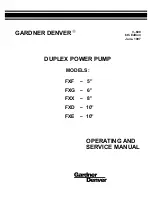
Installation
Discharge piping checklist
Checklist
Check
Explanation/comment
Checked
Check that an isolation valve is in-
The isolation valve is required for:
stalled in the discharge line. For spe-
• Priming
cific gravity less than 0.60, minimize
• Regulation of flow
distance from pump discharge.
• Inspection and maintenance of the pump
• Reduce risk of pumpage vaporization and vapor
locking at low flow rates for low specific gravity
liquids.
Check that a check valve is installed in The location between the isolation valve and the
the discharge line, between the isola-
pump allows inspection of the check valve.
tion valve and the pump discharge
The check valve prevents damage to the pump and
outlet.
seal due to the back flow through the pump, when
the drive unit is shut off. It is also used to restrain
the liquid flow.
If increasers are used, check that they
are installed between the pump and
the check valve.
If quick-closing valves are installed in
This protects the pump from surges and water
the system, check that cushioning de- hammer.
vices are used.
Bypass-piping considerations
When to use a bypass line
Provide a bypass line for systems that require operation at reduced flows for prolonged
periods. Connect a bypass line from the discharge side (before any valves) to the source of
suction.
When to install a minimum-flow orifice
You can size and install a minimum-flow orifice in a bypass line in order to prevent bypassing
excessive flows. Consult your ITT representative for assistance in sizing a minimum-flow
orifice.
When a minimum-flow orifice is unavailable
Consider an automatic recirculation control valve or solenoid-operated valve if a constant
bypass (minimum-flow orifice) is not possible.
Model 3610, API Type BB1 API 610 11th Edition Installation, Operation, and Maintenance Manual
33
















































